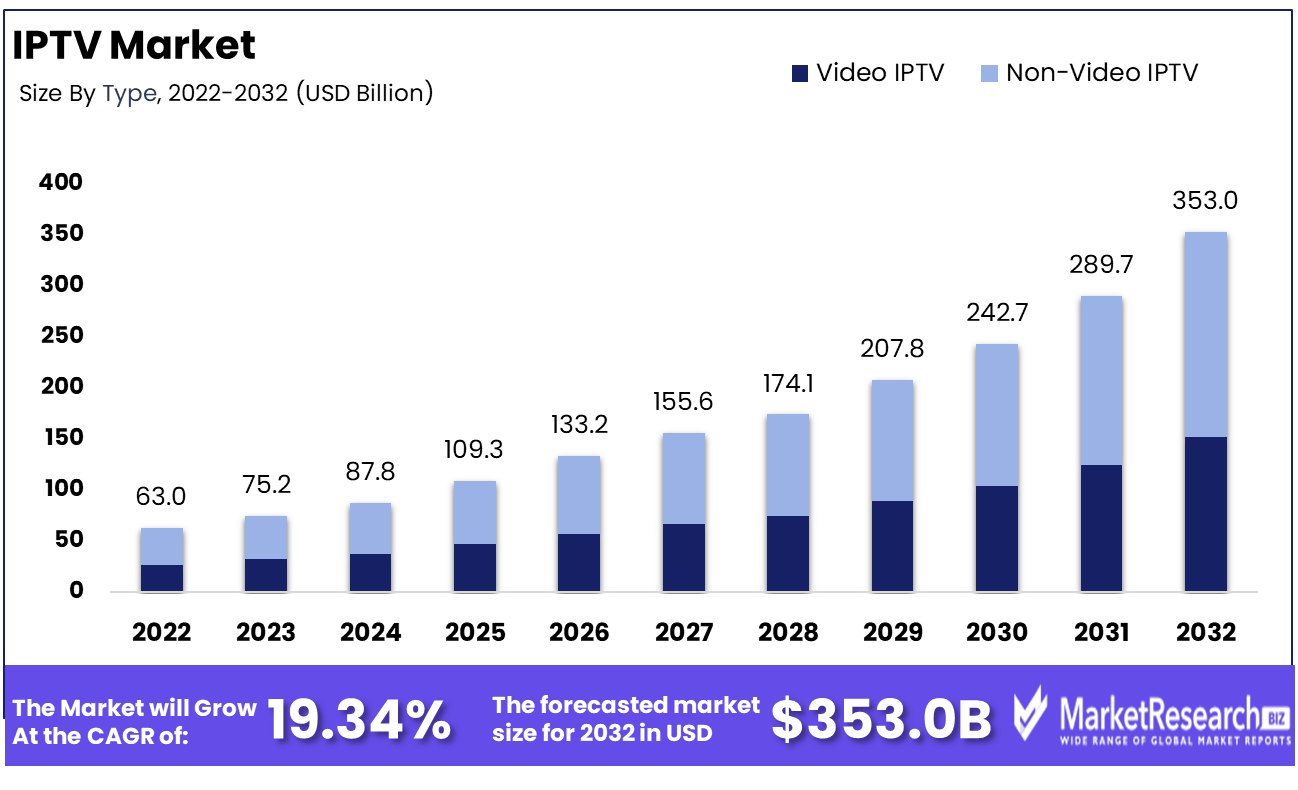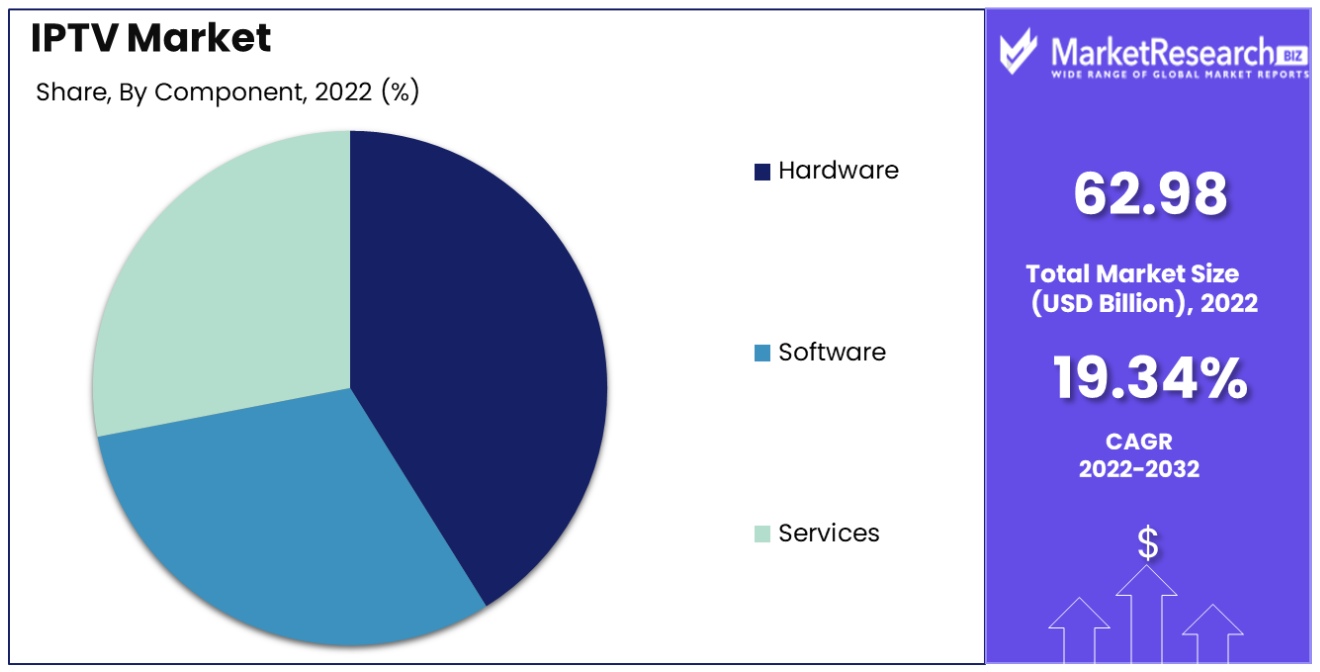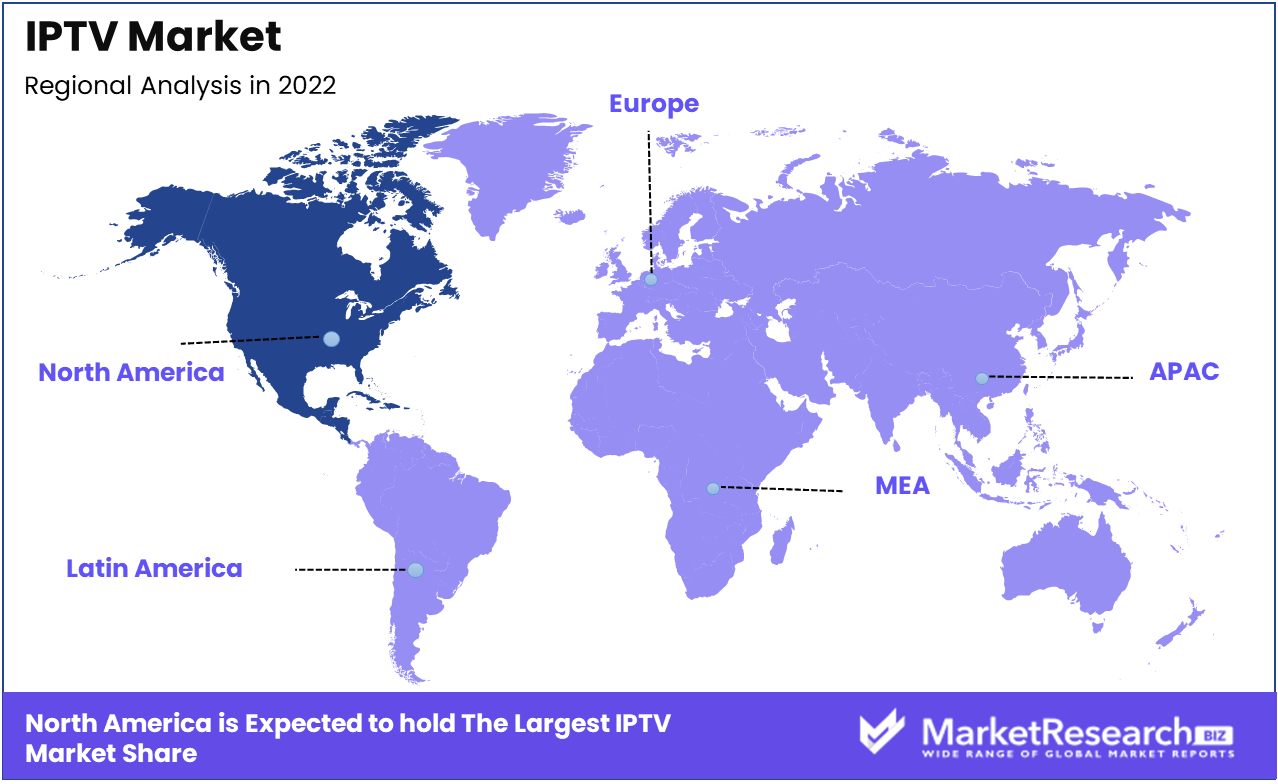
Global IPTV Market By Type (Non-Video Television, Video Television), By Service Analysis (Subscription based, Subscription free), By Component( Hardware, Software, Services), By Industry (Advertising and Marketing, Media and Entertainment,and Others),By Region And Companies - Industry Segment Outlook, Market Assessment, Competition Scenario, Trends, And Forecast 2023-2032
-
20650
-
June 2023
-
180
-
-
This report was compiled by Vishwa Gaul Vishwa is an experienced market research and consulting professional with over 8 years of expertise in the ICT industry, contributing to over 700 reports across telecommunications, software, hardware, and digital solutions. Correspondence Team Lead- ICT Linkedin | Detailed Market research Methodology Our methodology involves a mix of primary research, including interviews with leading mental health experts, and secondary research from reputable medical journals and databases. View Detailed Methodology Page
-
Quick Navigation
The IPTV market was valued at USD 62.98 billion in 2022. It is expected to reach USD 353.0 billion by 2032, with a CAGR of 19.34% during the forecast period from 2023 to 2032.

The surge in demand for customized and on-demand content, and the change in consumer preferences are some of the main driving factors for the IPTV market. Internet Protocol Television (IPTV) allows individuals to visualize their desired television programs and videos over the Internet by removing the hassle of traditional cable. IPTV uses an IP address or VoIP to provide TV channels, videos and live on-demand channels.
It is one type of digital television platform that provides subscribed consumers multiple services through internet protocol via an internet connection. It is a bit different from the traditional satellite connection TV used by millions of websites or applications such as YouTube, NetFlix, Amazon, and Hotstar. Moreover, IPTV provides only subscriptions that can be utilized on many devices.
IPTV services provide access to various TV programs through an internet connection. Most of the subscriptions are paid but some are free. The paid subscriptions are often more affordable than old cable subscriptions. It has made sure to stream video content on the consumer's feasible schedule instead of the cable service provider's schedule.
As per an article published by Global Sound Authority in 2022, more than 11 million individuals have subscribed to IPTV in the USA. Moreover, there will be around 6.3 million user subscribers in 2023. These numbers can be in the billions as there are many IPTV users globally.
Additionally, according to the Telecommunication Policy, the incorporation of global OTT services into local IPTV services leads local IPTV subscribers to get easy access to OTT services. It also provides practical benefits to global OTT service providers. There will be around 900,000 NetFlix users in Korea in 2028, when available to local IPTV service providers. This number has surged to 2.52 million in 2019 and 6.37 million in 2020.
This information supports the collaboration with local IPTV service providers that have several consumers in the local pay TV market that would also help the global OTT services enter into new markets with the help of global IPTV services.
Advanced technology plays a vital role in the IPTV market. The combination of 5G and IPTV offers exciting possibilities in the entertainment industry. 5G provides high speed and low latency that ensure a hassle-free streaming experience by removing buffering problems and offers smooth playback even for high-resolution content. This will change the visualizing content experience and is expected to contribute to the IPTV market growth in the coming years.
Driving Factors
Video-On-Demand Preference Boosts IPTV Market
The growing preference for Video-On-Demand (VOD) services is a significant factor propelling the IPTV market's growth. Consumers' increasing desire for on-demand content, where they can choose what and when to watch, aligns perfectly with IPTV's capabilities.
The transition from conventional broadcast models to Video on Demand (VOD) has prompted IPTV providers to broaden their content collections and enhance user interfaces, thereby increasing their attractiveness to a broader audience. The trend indicates a long-term market growth trajectory, with IPTV platforms continually adapting to meet evolving viewer preferences for content consumption.
High-Definition Channel Demand Enhances IPTV Appeal
Increasing demand for high-definition (HD) channels is driving the IPTV market forward. As consumers seek higher-quality video experiences, IPTV providers are expanding their HD channel offerings to meet this demand.
The major shift towards higher-quality viewing experiences is not only improving customer satisfaction but also setting a new standard in the broadcast industry. The focus on HD content is likely to persist, further cementing IPTV's position in the market as a provider of premium viewing experiences.
Alternative Investment Demand Spurs IPTV Innovation
The rise in demand for alternative investment in the broadcasting and media sector is positively impacting the IPTV market. As investors seek new opportunities outside traditional media, IPTV platforms are receiving more funding for technological advancements and market expansion.
The influx of investment is enabling IPTV providers to innovate, improve service quality, and explore new market segments. The long-term implication is a more dynamic IPTV market, characterized by rapid technological advancements and expanded service offerings.
Digital Transformation Technology Utilization Accelerates Market Growth
The increase in the use of digital transformation technology is a key driver in the expansion of the IPTV market. As more households and businesses adopt digital technologies, the integration and utilization of IPTV services become more prevalent. This trend reflects a broader shift towards digitalization in media consumption.
IPTV providers are leveraging these technologies to offer more personalized, interactive, and integrated viewing experiences. The anticipated long-term effect is a market that continuously evolves, incorporating the latest digital technologies to meet the changing needs of a tech-savvy audience.
Restraining Factors
Stringent Regulatory Norms and Low Content Availability Restrain IPTV Market Growth
The growth of the IPTV market is significantly hindered by stringent regulatory norms and the challenge of content availability. Regulatory environments vary greatly across regions, often imposing strict controls over content distribution and broadcasting rights. These regulations can limit the scope of content that IPTV providers can offer, directly impacting their ability to attract and retain subscribers.
Additionally, the acquisition of broadcasting rights for popular content can be both costly and complex, further restricting content diversity. This combination of regulatory hurdles and limited content availability poses a substantial barrier to market expansion, especially in regions with particularly stringent controls.
Vulnerability to Piracy and Unauthorized Content Sharing Restrains IPTV Market Growth
Piracy and unauthorized content sharing represent major challenges for the IPTV market. The digital nature of IPTV services makes them particularly susceptible to illegal distribution and piracy. This not only leads to significant revenue losses for content creators and providers but also attracts legal issues, damaging the industry's reputation and reliability.
Furthermore, the ease of accessing pirated content often discourages consumers from subscribing to legitimate IPTV services, thus directly impacting market growth. Combating piracy requires investment in security and anti-piracy measures, adding to operational costs for IPTV providers and complicating the market landscape.
IPTV Market Segmentation Analysis
By Type
Video IPTV, offering television content over Internet Protocol networks, dominates the IPTV market. This segment's growth is driven by the rising demand for high-definition, on-demand video content, and interactive TV services. Consumers' preference for customizable viewing experiences and the ability to access a vast library of content at convenience bolsters this segment. The proliferation of high-speed internet and the increasing adoption of smart TVs and mobile viewing devices are key factors contributing to its growth.
Non-video IPTV, though a smaller segment, plays a significant role in providing services like digital signage, e-learning, and telemedicine. This segment's growth is particularly noticeable in the corporate and educational sectors, where IPTV is used for training and information broadcasting.
By Service Analysis
Subscription-based services are the mainstay of the IPTV market. This model's success is attributed to its consistent revenue generation and the ability to offer diverse, premium content packages. Subscription-based IPTV services are increasingly integrating with OTT (over-the-top) platforms to broaden their content offerings, attracting a wider audience base.
Subscription-free services, offering limited content at no ongoing cost, cater to a niche market segment. This model is particularly appealing in regions with lower purchasing power or as an entry-level service for new IPTV users.
By Component
In the IPTV market, the hardware component, encompassing set-top boxes and networking devices, plays a fundamental role. Notably, innovations in hardware technology, such as enhanced Wi-Fi capabilities and support for 4K video, are critical in elevating user experiences. These improvements help in delivering higher-quality content and smoother streaming, which are key factors in attracting and retaining customers in the competitive IPTV market.
Software solutions are equally crucial, serving as the backbone for content management and streaming functionalities. The development and enhancement of software that provides intuitive user interfaces and facilitates personalized content delivery are becoming increasingly vital. As the market grows, the need for sophisticated software that can handle diverse content types and provide seamless streaming experiences is paramount. Additionally, services like professional installation, maintenance, and customer support play a crucial role in ensuring the smooth operation and longevity of IPTV systems.

By Industry
In the IPTV market, the media and entertainment industry stands out as a dominant player. This industry leverages IPTV for effective content distribution and monetization, benefiting significantly from the shift toward digital platforms. The rising demand for a variety of entertainment options is a major driver for the growth of IPTV in this sector.
Moreover, IPTV is increasingly being utilized in advertising and marketing for targeted content delivery, allowing for more effective and personalized advertising strategies. In the IT and telecom sectors, IPTV is embraced as a value-added service, enhancing the overall service portfolio and customer satisfaction. The healthcare industry is also incorporating IPTV, using it for patient education and entertainment, which contributes to improved patient experiences.
By Transmission Method
In the IPTV market, wired transmission remains the preferred choice due to its stability and capacity for high-quality content delivery. This method's reliability and high bandwidth capability are ideal for IPTV services, particularly in regions with robust telecommunications infrastructure. It ensures uninterrupted streaming of high-definition content, a key factor in user satisfaction.
Conversely, wireless transmission is becoming increasingly popular, driven by advancements in wireless technologies and a rising demand for mobility in content consumption. This method is especially appealing in areas with limited wired infrastructure and serves as a complement to traditional wired services, offering flexibility and convenience to users who prefer to access content on various devices and on the go.
By Offering
Standalone IPTV services specifically target consumers whose primary interest lies in accessing television content. This model appeals to users who prefer a focused, television-centric entertainment experience without the additional services that often come in bundled packages. Standalone IPTV's strength lies in its ability to offer a wide array of television content, including live channels, on-demand programs, and exclusive series, tailored to meet diverse viewer preferences.
On the other hand, bundled services, which combine IPTV with internet and/or telephony, are increasingly popular in the market. These bundles offer a holistic digital solution, making them attractive to customers who value convenience and the synergistic benefits of combining multiple services into one package. The bundled model's appeal lies in its comprehensive nature, addressing a broader range of digital needs for consumers in an integrated and cost-effective manner.
Based on End User
The residential sector, as the primary end-user of IPTV, significantly drives market growth. This sector's expansion is propelled by the rising consumer demand for personalized and interactive home entertainment experiences. With advancements in technology, IPTV services now offer features like video-on-demand, interactive TV, and personalized content, which are highly appealing to home users. Furthermore, as work-from-home arrangements become more common, the demand for high-quality home entertainment, including IPTV, is expected to see a notable uptick, contributing to the sector's growth.
In the enterprise domain, IPTV's role extends beyond entertainment, serving as a tool for effective internal communication and training. It enables organizations to distribute content seamlessly across various departments and locations, facilitating better information dissemination and employee engagement. This broad application scope in the enterprise sector further diversifies the IPTV market and contributes to its overall growth.
By Type
- Video IPTV
- Non-Video IPTV
By Service Analysis
- Subscription-based
- Subscription free
By Component
- Hardware
- Software
- Services
By Industry
- Media and Entertainment
- Advertising and Marketing
- IT and Telecom
- Healthcare
- Others
By Transmission Method
- Wired
- Wireless
- By Offering
- Standalone
- Bundled
Based on End User
- Residential
- Enterprises
- Small Enterprise
- Medium Enterprises
- Large Enterprises
Growth Opportunities
Increasing Internet Penetration Offers Growth Opportunity
The expansion of internet penetration worldwide is a significant driver for IPTV market growth. As internet access becomes more widespread, especially in developing regions, it opens up a vast new customer base for IPTV services. Recent data shows a continuous increase in global internet users, with significant growth in areas previously underserved by traditional broadcasting.
This trend not only facilitates wider access to IPTV but also encourages investments in network infrastructure, enhancing service quality. With internet speeds improving and becoming more affordable, IPTV providers can offer more reliable and high-quality streaming services, attracting a broader audience.
Content Management and Analytics Offers Growth Opportunity
Effective content management and advanced analytics play a pivotal role in the growth of the IPTV market. By utilizing sophisticated content management systems, IPTV providers can tailor their offerings to meet diverse viewer preferences, enhancing user engagement and satisfaction.
Moreover, analytics allow for a deeper understanding of viewer habits and trends, enabling providers to make data-driven decisions on content acquisition and curation. This approach not only improves viewer retention rates but also attracts advertisers by offering targeted advertising opportunities based on viewer data. Additionally, analytics-driven insights can guide investment in original content, further distinguishing IPTV services in a competitive market.
Regional Analysis
North America Dominates with Significant Market Share
North America's significant share in the IPTV market is underpinned by its highly developed telecommunications infrastructure and a tech-savvy consumer base. The region's rapid adoption of high-speed internet and the proliferation of smart devices have been crucial drivers. Additionally, the presence of leading content providers and technology companies that offer diverse and high-quality IPTV services plays a vital role.

The IPTV market in North America is also characterized by a strong demand for on-demand and streaming services, reflecting changing consumer preferences away from traditional television. The competitive landscape, driven by both established players and emerging challengers, fosters a dynamic market environment.
Looking ahead, the IPTV market in North America is poised for continued growth. The ongoing advancements in internet infrastructure, like the rollout of 5G networks, will likely enhance streaming quality and service reliability, further boosting IPTV adoption. Furthermore, the increasing trend towards cord-cutting and the growing appetite for exclusive content and niche channels will continue to drive the market forward.
Europe: A Market Driven by Diversity and Innovation
Europe's IPTV market is growing, driven by a diverse audience and a strong focus on innovation. The region’s robust internet infrastructure and the presence of multiple languages and cultures have led to a wide range of localized IPTV services. European regulations promoting fair competition and data privacy also provide a stable environment for market growth. Additionally, the increasing trend of integrating IPTV with smart home technology is gaining traction in the region.
Asia-Pacific: Rapid Expansion and Technology Adoption
The IPTV market in Asia-Pacific is experiencing rapid expansion. Factors such as the increasing penetration of high-speed internet, a large and diverse population, and a growing middle class contribute to this growth. Countries like South Korea and Japan are at the forefront of technological adoption in IPTV, offering advanced features like 4K and VR content. Furthermore, the region’s appetite for local and regional content drives the demand for localized IPTV services, making it a vibrant and fast-evolving market.
IPTV Industry by Region
North America
- The US
- Canada
Europe
- Germany
- France
- The UK
- Spain
- Italy
- Russia
- Netherlands
- Rest of Europe
Asia-Pacific
- China
- Japan
- South Korea
- India
- New Zealand
- Singapore
- Thailand
- Vietnam
- Rest of Asia Pacific
Latin America
- Brazil
- Mexico
- Rest of Latin America
Middle East & Africa
- South Africa
- Saudi Arabia
- UAE
- Rest of the Middle East & Africa
Key Player Analysis
In the IPTV market, a key segment of the rapidly evolving digital entertainment industry, the listed companies each play a significant role. AT&T Inc. and Bharti Airtel Limited, with their extensive telecom networks, exemplify the synergy between IPTV services and telecommunications infrastructure, highlighting the importance of robust network capabilities in delivering high-quality IPTV content.
CenturyLink Inc. and Deutsche Telecom, offering advanced IPTV services, underscoring the market's shift towards integrating traditional broadcasting with over-the-top (OTT) streaming technologies. ARRIS Group Inc. and Cisco Systems Inc., known for their network equipment and technologies, reflect the critical need for efficient content distribution and management systems in the IPTV landscape.
Broadcom Corporation and Ammino Corporation, specializing in chipset and hardware solutions, demonstrate the importance of technological innovation in enhancing IPTV service delivery and user experience. MatrixStream Technologies Inc. and Orange S.A., with their focus on end-to-end IPTV solutions, showcase the trend towards comprehensive service offerings encompassing everything from content aggregation to delivery and playback.
Akamai Technologies, Inc. and Ericsson AB, leaders in network and content delivery technologies, highlight the essential role of advanced networking and cloud solutions in scaling IPTV services. Huawei Technologies Co., Ltd. and Verizon Communications, with their expansive digital and telecommunications footprints, illustrate the growing convergence of various digital services, including IPTV, within broader digital ecosystems.
TRIPLE PLAY SERVICES LTD, focusing on enterprise-level IPTV solutions, underscores the market's expansion beyond consumer entertainment into diverse applications such as hospitality and education. Collectively, these companies not only drive the IPTV market's growth but also embody a range of strategic approaches, from network infrastructure enhancement to innovative content delivery solutions, crucial in shaping this dynamic sector.
Key Players
- AT&T Inc
- Bharti Airtel Limited
- CenturyLink Inc.
- Deutsche Telecom
- ARRIS Group Inc.
- Cisco Systems Inc
- Broadcom Corporation
- Ammino Corporation
- MatrixStream Technologies Inc.
- Orange S.A.
- Akamai Technologies, Inc.
- Ericsson AB
- Huawei Technologies Co., Ltd.
- Verizon Communications
- TRIPLEPLAY SERVICES LTD
Recent Development
- In October 2023, Evolution Digital announced a preferred development partnership with TiVo to provide service providers with a fast path to a premium video offering for their subscribers. This partnership aims to offer a fully managed IPTV service by TiVo.
- In September 2023, Al Arabiya, a part of MBC Group, entered into a strategic partnership with Vianeos, a French-based company specializing in flexible and advanced IPTV & OTT middleware servers with intuitive user interfaces for various platforms. This partnership aimed to enhance Al Arabiya's existing internal IPTV system with cutting-edge technologies.
- In 2023, The BBC, ITV, Channel 4, and Channel 5 announced the development of a new IPTV platform called 'Freely.' This platform aims to deliver live TV over UK home broadband connections, offering both live TV channels and on-demand content.
- In 2023, Türk Telekom transformed its new-generation TV service, Tivibu, with the assistance of ZTE and Netas. They introduced a new channel called Tivilife, exclusively available on the platform, which combines new trends from entertainment to nature, travel to food, health to fashion.
Report Scope
Report Features Description Market Value (2022) USD 62.98 Billion Forecast Revenue (2032) USD 353.0 Billion CAGR (2023-2032) 19.34% Base Year for Estimation 2022 Historic Period 2016-2022 Forecast Period 2023-2032 Report Coverage Revenue Forecast, Market Dynamics, COVID-19 Impact, Competitive Landscape, Recent Developments Segments Covered By Type (Non-Video Television, Video Television), By Service Analysis (Subscription based, Subscription free), By Component( Hardware, Software, Services), By Industry (Advertising and Marketing, Media and Entertainment, IT and Telecom, Healthcare, Others), By Transmission Method (Wired, Wireless, By Offering, Bundled, Standalone), Based on End User (Enterprises, Small Enterprise, Medium Enterprises, Large Enterprises, Residential) Regional Analysis North America - The US, Canada, Europe - Germany, France, The UK, Spain, Italy, Russia, Netherlands, Rest of Europe, Asia-Pacific - China, Japan, South Korea, India, New Zealand, Singapore, Thailand, Vietnam, Rest of Asia Pacific, Latin America - Brazil, Mexico, Rest of Latin America, Middle East & Africa - South Africa, Saudi Arabia, UAE, Rest of Middle East & Africa Competitive Landscape AT&T Inc., Bharti Airtel Limited, CenturyLink Inc., Deutsche Telecom, ARRIS Group Inc., Cisco Systems Inc., Broadcom Corporation, Ammino Corporation, MatrixStream Technologies Inc., Orange S.A., Akamai Technologies, Inc.,Ericsson AB, Huawei Technologies Co., Ltd., Verizon Communications, TRIPLE PLAY SERVICES LTD Customization Scope Customization for segments, region/country-level will be provided. Moreover, additional customization can be done based on the requirements. Purchase Options We have three licenses to opt for Single User License, Multi-User License (Up to 5 Users), Corporate Use License (Unlimited User and Printable PDF) -
-
- AT&T Inc
- Bharti Airtel Limited
- CenturyLink Inc.
- Deutsche Telecom
- ARRIS Group Inc.
- Cisco Systems Inc
- Broadcom Corporation
- Ammino Corporation
- MatrixStream Technologies Inc.
- Orange S.A.
- Akamai Technologies, Inc.
- Ericsson AB
- Huawei Technologies Co., Ltd.
- Verizon Communications
- TRIPLEPLAY SERVICES LTD




